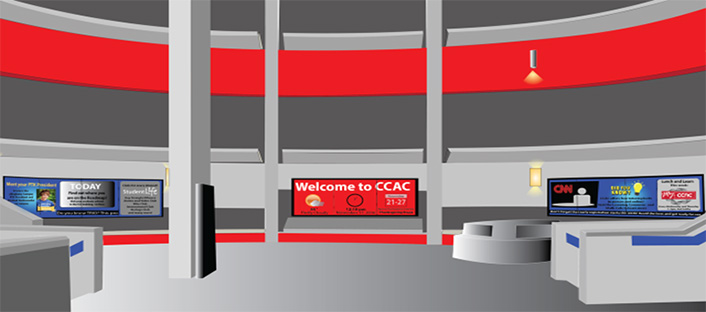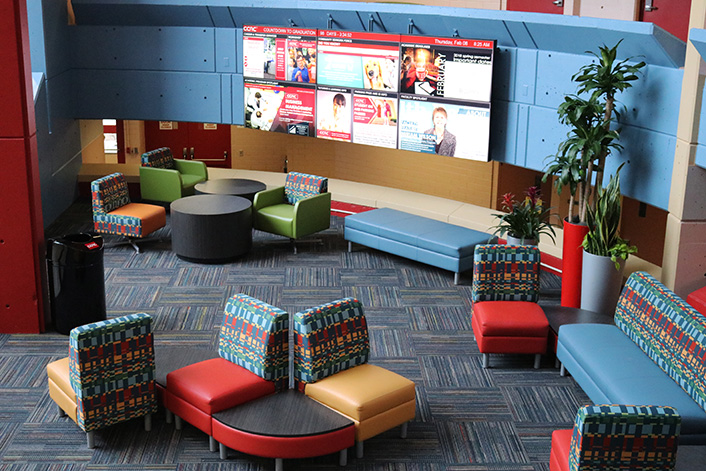A student-led project created a technology-enabled gathering place that increases student engagement with information, programs, and services.

Like many other institutions of higher education, the Community College of Allegheny County (CCAC) strives to keep pace with the technological preferences of its millennial learners. Inspired by these first-generation digital natives, CCAC has engaged in an intentional, self-reflective examination of both its everyday business processes and its learning environments.
One outcome of this self-reflection has been CCAC's renewed focus on integrating technology to enhance student access and success. This has led to improved online services for new and continuing students, including software such as TouchNet, an online payment system; the E-Advise online advising program; and E-Recruit to facilitate customized communication with prospective students. It has also resulted in several other initiatives aligned with CCAC's student-centered focus.
Among those initiatives is a project led by Allegheny campus Phi Theta Kappa (PTK) student leaders, who collaborated with diverse college stakeholders to transform a building's rotunda into an innovative technology-enabled space to enhance student interaction and engagement.
PTK Project Overview
The students chose the rotunda redesign as their capstone project for the PTK honor society. In addition to conducting student surveys, these student leaders, along with their staff advisor, worked closely with faculty, IT and facility personnel, and the campus president's office over an eight-month period to conceptualize and implement a technology-enabled space aimed at enhancing student engagement.
Campus President Evon Walters describes the Milton Rotunda project (3:12 minutes)
The students based their plan on research findings that show that students who are informed about and fully engaged in the academic and social life of the institution are more likely to persist in meeting their academic goals.1 Their project goal was to redesign the rotunda in Milton Hall, the largest academic building on the Allegheny campus. Today, the redesigned Milton Rotunda features video walls, interactive kiosks, and digital wayfinding and informational signage to offer students easier access to information, programs, and services.
The Allegheny Campus
The largest of CCAC's four campuses, the Allegheny campus has 6,300 students and is located on Pittsburgh's north side. Its largely first-generation student body draws from 45 school districts. Most of its students (71 percent) are under 29 years of age and 25 percent are from historically under-represented populations. More than 65 percent of Allegheny students attend part-time and must balance their schooling with the complex realities of family and work obligations. This demographic reality motivated the PTK students' ambitious planning and renovation project.
The Setting
Milton Hall is the largest academic building on campus. In addition to housing an assortment of academic programs, it features the Milton Rotunda (see figure 1), one of the largest open public spaces on campus. Located on the second floor of Milton Hall, the rotunda is a high-traffic area where students often congregate. From our PTK student leaders' perspective, however, the space had several problems, including a circular and largely windowless layout that made it impossible to visualize its relationship to classes both within and outside the building. It was also largely empty, with no inviting centralized area for students to socialize, study, and learn about college-related opportunities and programs.

As student Dylan Yee, a PTK officer, noted, "Students complained that it was an unappealing large space that had an industrial and unwelcoming feel. Given its size and poor signage, it was disorienting, particularly for new students."
The Process
The PTK student leaders decided to take up the challenge and redesign this space. They first spearheaded a planning process; this evolved into the creation of a taskforce with representatives from a diverse cross-section of stakeholders, including faculty who teach classes in the building, and staff members from the IT department, the facilities department, and senior administration. The taskforce also included subcommittees, one of which was dedicated to technology.
The technology subcommittee benchmarked best practices both within and outside higher education and looked closely at spaces that were architecturally designed to be customer friendly and focused. In addition to peer institutions, the subcommittee studied successfully planned malls, airports, and hotels. Based on this research and after multiple meetings, the taskforce solidified its vision: to transform the rotunda into a welcoming, 21st-century technology-enabled environment that would enhance information sharing, expand transactional capacity, and improve wayfinding signage (see figure 2).

Team members presented the resulting conceptual design to the college president, the board of trustees, and the cabinet, and they received enthusiastic endorsement. This, along with $350,000 in support funding, launched the project into its implementation phase.
Building the New Space
To build the new technology-enabled space, the IT subcommittee had two challenging tasks:
- Create a centralized space where students could socialize, study, and access information on college initiatives, opportunities, and programs
- Create a wayfinding system that would enhance students' ability to locate classrooms and offices within and outside Milton Hall
Searching for Solutions
The IT subcommittee investigated several software solutions, eventually focusing on software that could be programmed for content on a regular basis and would integrate with other solutions. Interim Information Technology Services (ITS) Director Megan Rice reported on this process:
We found that many solutions did not provide Active Directory integration and often used shared usernames and passwords. Ultimately, based on what we gathered as customer expectations — specifically the students' — we identified two products that seemed to meet all of our needs.
The IT subcommittee then convened a college-wide team to meet with and review vendor demonstrations; it then administered an anonymous survey and used the results to choose the software.
To determine the best hardware for the intended purposes, the subcommittee invited multiple vendors to offer recommendations. What it found, however, was a lack of consensus about best practices, technologies, and specific products. After consulting with ITS, the subcommittee then turned to Horizon, a tech organization that the college had worked with on several successful projects. With Horizon's assistance, committee members explored the hardware needed to deliver a solution that not only met student expectations but also provided a wow factor when students walked into the space. As one member put it, "We wanted it to stand out — to be a place that was the spot everyone wanted to show off."
Producing Outcomes
As figure 3 shows, the technological additions to the space include video walls, a wayfinding kiosk, informational screens, TVs streaming the news with closed captioning, and transactional kiosks. The video walls replaced static, outdated flyers that had previously been posted on walls, doors, and windows. In addition to the aesthetic improvement, the video walls expanded the campus's capacity to communicate and engage with its students. By establishing more-streamlined internal communications between the institution and students, the new technology facilitates quick and effective updates on information such as internship opportunities, support services, safety, and student-life programs.

The rotunda's transactional and wayfinding kiosks are also student-centered tools, supporting students in conducting business, such as class registrations, without leaving the space, as well as helping them easily find classrooms in Milton Hall and elsewhere on campus (see figure 4). To meet the goal of creating a warmer, more welcoming space, the students and faculty consulted with an interior designer to integrate and complement the technology with carpeting, soft seating in complementary color schemes, and international flags to represent the college's global diversity.

Redesigning Engagement
Whether within or outside the classroom, engagement is crucial to student success. Students who are less engaged are at the greatest risk of dropping out. It is thus essential that institutions create multiple ways to build relationships between students and faculty, staff, and peers.
Once considered a cut-through pedestrian route, the Milton Rotunda was a majestic yet underutilized space that was failing to serve the campus's highly transient student population. The rotunda now offers our students multiple choices for engagement as they traverse between classes or between the campus and work or home.
Jacqueline Cavalier, a history professor and faculty mentor on the project, elegantly summed up the redesigned rotunda's value:
This space will foster new relationships; people will meet here to work, to study, to talk, perhaps to champion a cause that is important to them. This is our place…. All of this is important to our sense of identity, and it is important to our sense of belonging to the community that we call CCAC.
Note
- Alexander W. Astin, "Student Involvement: A Developmental Theory for Higher Education," Journal of College Student Personnel, Vol. 25, No. 4, 1984: 297–308; and Kay M. McClenney and Nathan C. Marti, Exploring Relationships Between Student Engagement and Student Outcomes in Community Colleges: Report on Validation Research, Community College Survey of Student Engagement, 2006: 145. ↩
Evon Walters is President of the Allegheny Campus/Homewood Brushton Center of the Community College of Allegheny County.
© 2018 Evon Walters.
